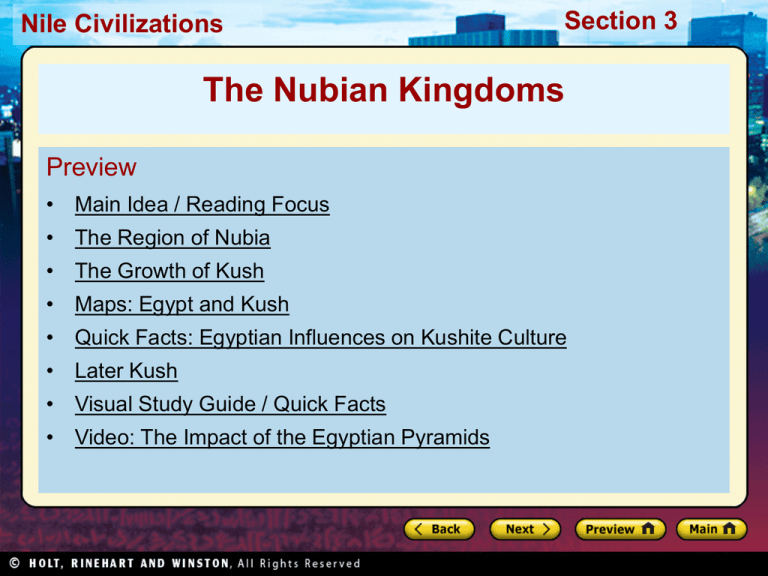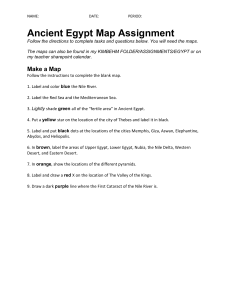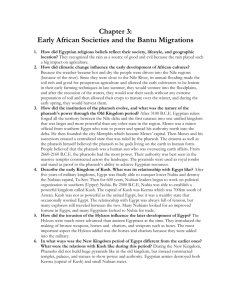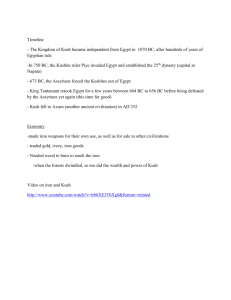3.3 The Nubian Kingdom
advertisement

Nile Civilizations Section 3 The Nubian Kingdoms Preview • Main Idea / Reading Focus • The Region of Nubia • The Growth of Kush • Maps: Egypt and Kush • Quick Facts: Egyptian Influences on Kushite Culture • Later Kush • Visual Study Guide / Quick Facts • Video: The Impact of the Egyptian Pyramids Section 3 Nile Civilizations The Nubian Kingdoms Main Idea One of ancient Africa’s most advanced civilizations, Kush developed along the Nile south of Egypt in a region called Nubia. Reading Focus • What were the land and people of Nubia like? • How did Kush grow into a major civilization? • How did Kushite society change in its later period? Section 3 Nile Civilizations The Region of Nubia Nubia located south of Egypt along the Nile • Boundaries – Blue Nile, White Nile flow together to form Nile – Where rivers meet near Khartoum may have been southern Nubian boundary – Region stretched north to first cataract, Egypt’s southern boundary • Nubians depended on Nile – Landscape made farming difficult – Nile flows through rocky mountains in Nubia Section 3 Nile Civilizations The Region of Nubia A Wealth of Resources • • • • • Nubia had great mineral wealth Mines produced gold, granite, precious stones Location was also a valuable resource Goods from central Africa to other lands flowed into Nubia Goods traded through Nubia included animal skins, ivory, ebony, slaves Nubia’s People • Egyptian writings explain Nubia • Nubians skilled potters, expert traders and archers • Egyptians called Nubia the Land of the Nine Bows • Some Egyptian rulers hired Nubian archers as police, soldiers Early History • Nubia formed at same time as Egypt’s Old Kingdom • Nubia possessed great wealth • Nubia and Egypt became rivals • Egypt conquered Nubia during Middle Kingdom • Nubia adopted Egyptian culture Nile Civilizations Section 3 Compare and Contrast How was Nubia similar to and different from Egypt? Answer(s): similar—both situated on the Nile, depended on the river; different—in Egypt, the Nile flows through rich farmland, in Nubia it flows through rocky mountains, and farming is almost impossible; Nubia produced valuable minerals that could be traded Section 3 Nile Civilizations The Growth of Kush Northern Nubia was controlled by Egypt during the Middle Kingdom, while a powerful southern Nubian state called Kush began to develop. Beginnings of Power • Egypt’s Middle Kingdom collapsed around 1700 BC • Kush expanded to rule all Nubia – Alliance with Hyksos – Trade increased – Used wealth to build royal tombs in Kerma • New Kingdom Egyptians conquered Kush, 1500 BC Egyptians in Kush • Egypt ruled 400 years • Egyptian rulers built temples, monuments throughout Kush • Kush regained power after reign of Ramses the Great • Free of Egyptian control by 1100 BC • Kushites weak, disorganized after years of Egyptian control Section 3 Nile Civilizations The Growth of Kush Kushites in Egypt Piankhi • New Kushite kingdom, 750 BC • Described as compassionate ruler, ruthless warrior • Began to grow and strengthen • Conquered all of Egypt • Kush’s rulers decided to expand power to a weakened Egypt after fall of New Kingdom • Piankhi led Kushites north into Egypt • Kushite rulers held power only about a century • Mid-600s BC, Assyrians swept into Egypt, pushed Kushite pharaohs back into Nubia Nile Civilizations Section 3 Section 3 Nile Civilizations The Growth of Kush Kushite Culture • Kushite pharaohs, guardians of Egyptian tradition – Had bodies mummified, buried in pyramids – Adopted Egyptian hieroglyphics as writing system • Did not abandon all their own customs – Did not adopt Egyptian style of dressing – Statues show distinctly Nubian features, clothing – Statues show pharaohs wearing crown with two cobras, symbol of union of Egypt and Kush Nile Civilizations Section 3 Section 3 Nile Civilizations Summarize How did the relationship between Kush and Egypt change? Answer(s): Egyptians drove the Hyksos out and invaded Kush. As the New Kingdom weakened, Egyptian power over Kush declined. After a few centuries, Kushites pushed north into Egypt, eventually conquering all of it. When the Assyrians swept into Egypt, the Kushites fled back into Nubia. Section 3 Nile Civilizations Later Kush There are few records for the period immediately following the Kushite expulsion from Egypt. However in the mid-200s BC, the Kushites moved their capital farther south along the Nile from Napata to Meroë. The scope of change in culture was so great, some refer later Kush as a separate culture. City of Meroë • Near junction of two rivers Iron Industry • Abundant mineral resources nearby Later Culture • Abandoned some Egyptian culture • “Island of Meroë” • Iron also plentiful • Created own writing system • Homes of wood from nearby forests • Area home to many species of wild animals – Most valuable product – Shipped in Nile Valley – Wealth supported expansion • Mysteries remain – – – – Role of women? High status? Female rulers? Regents? Nile Civilizations Section 3 Decline of Meroë • Economy strong as long as trade thrived • Decline in trade began in 200s AD • As economy declined, so did kingdom • Aksum invaded, destroyed Meroë, 350 AD, Kushite civilization faded Factors in Decline of Meroë • Competition for goods reduced demands for Kushite exports • Trade routes linking Meroë to outside world disturbed by raids • Centuries of iron making took toll on Nubian forests • Wood for forges to smelt iron no longer available • Kushites could no longer work iron to make tools they needed Section 3 Nile Civilizations Analyze How did Kushite civilization change after the capital moved to Meroë? Answer(s): abandoned many Egyptian traditions; created own alphabet and writing system Nile Civilizations Section 3 Section 3 Nile Civilizations Video The Impact of the Egyptian Pyramids Click above to play the video.






